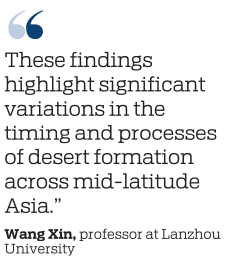Study reveals more about Taklimakan Desert


A study by Chinese scientists recently discovered that the existing landscape of the Taklimakan Desert in the Xinjiang Uygur autonomous region began taking shape approximately 300,000 years ago, and speculated that the initial formation of the desert dates back about 1.8 million years ago.
This timeline places the Taklimakan Desert as much older than the Badain Jaran and Tengger deserts in the Inner Mongolia autonomous region, which respectively emerged around 1.1 million and 900,000 years ago.
The Taklimakan Desert is the largest desert in China and the second-largest mobile desert in the world. Prior to this discovery, the timing of the formation of major deserts in China and Central Asia remained unclear in academic circles, according to Wang Xin, a professor from the College of Earth and Environmental Sciences at Lanzhou University.
"These findings highlight significant variations in the timing and processes of desert formation across mid-latitude Asia," he said.
"Apart from arid climate conditions, differences in material supply capacity caused by regional tectonics and geomorphological conditions may play a crucial role in the formation of the deserts and require further research," he added.
The research team, led by Wang and Chen Fahu, an academician from the Institute of Tibetan Plateau Research at the Chinese Academy of Sciences, analyzed a 200-meter drill core extracted from the center of the desert, as part of a larger 1,340-meter core sample.
Wang explained that the continuous accumulation of aeolian sand and the absence of fluvial and lacustrine sediments indicate that rivers and lakes have not reached the core of the desert, even during warmer and wetter periods over the past 300,000 years.
Since its initiation in 2008, the "Western Environmental Drilling Project" has conducted scientific drilling in the interiors of major deserts such as the Taklimakan Desert, Badain Jaran Desert, Tengger Desert and Gurbantunggut Desert.
The research titled "Spatial Heterogeneity in the Formation of Large Deserts in Mid-latitude Asia Revealed by Drill Core Evidence", was published in Science Bulletin in late September.
"The climatic and environmental effects of dust aerosols significantly impact global climate, biogeochemical cycles, marine ecosystems, and even the global carbon cycle," Wang said. He added that this research contributes to a better understanding of the long-term environmental changes in the deserts, a crucial source of dust for the Northern Hemisphere.
"Unraveling the history of the desert and its climate impacts will provide insights into how desert systems may respond to future climate changes," Wang said, noting that the team will continue studying the drill cores to gain further insights into the formation and evolution of these deserts.
yandongjie@chinadaily.com.cn

- Study reveals more about Taklimakan Desert
- Fridge magnets prove hot sales items at museums
- Xi stresses commitment to 'one country, two systems'
- China, Slovakia elevate ties
- China's Shenzhou-18 astronauts complete handover, returning to Earth on Monday
- New offshore platform taps into potential of heavy-oil reserves in China





































